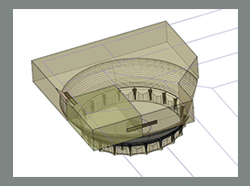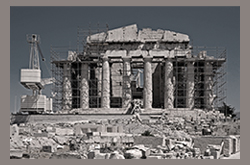scarica l’articolo in formato pdf: Calculating reinforcement for fragmented architectural members. A three dimensional approach
.
 Nel progetto di restauro dell’Acropoli di Atene molto spesso ci si imbatte in fratture significative sulle membrature architettoniche in marmo. La pratica comune dei lavori di restauro è quello di unire i frammenti di marmo insieme con barre filettate in titanio, inserite in fori praticati nel materiale lapideo e fissati in posizione con malta cementizia. La stima dei carichi di progetto di strutture come i monumenti dell’Acropoli è un compito molto difficile, soprattutto quando si considera la risposta sismica. Per questa ragione sono stati impiegati con ottimi risultati metodi elaborati e precisi e strumenti analitici. Recentemente l’analisi basata sugli elementi discreti sembra predire abbastanza accuratamente la risposta di queste strutture e fornisce un metodo efficace di tempo rispetto all’uso dell’analisi basata su elementi finiti. Ma l’impiego di tali metodi per calcolare l’armatura richiesta da ciascuna frattura non è ancora applicabile su larga scala, così, per facilitare il lavoro sul sito, si utilizzano ancora metodi semplificati. Fino ad ora, il metodo di calcolo per le armature necessarie consisteva nell’adottare analogie dimensionali semplificate per le fratture, per l’armatura e per le condizioni di carico. L’articolo illustra un metodo sintetico e semplificato per il calcolo dell’armatura richiesta per elementi architettonici frammentati, tenendo conto degli effetti delle tre dimensioni spaziali (geometria della frattura, geometria del rinforzo metallico e geometria del carico). In questo approccio si tiene conto del problema del calcolo della tensione prevista dell’armatura in complesse forme spaziali di frattura. Le ricadute più significative del progetto sono in un prodotto finale che abbia il carattere di uno strumento accessibile e facile da usare, in grado di rispondere in tempo reale e facilitare così il lavoro degli ingegneri civili sul sito.
Nel progetto di restauro dell’Acropoli di Atene molto spesso ci si imbatte in fratture significative sulle membrature architettoniche in marmo. La pratica comune dei lavori di restauro è quello di unire i frammenti di marmo insieme con barre filettate in titanio, inserite in fori praticati nel materiale lapideo e fissati in posizione con malta cementizia. La stima dei carichi di progetto di strutture come i monumenti dell’Acropoli è un compito molto difficile, soprattutto quando si considera la risposta sismica. Per questa ragione sono stati impiegati con ottimi risultati metodi elaborati e precisi e strumenti analitici. Recentemente l’analisi basata sugli elementi discreti sembra predire abbastanza accuratamente la risposta di queste strutture e fornisce un metodo efficace di tempo rispetto all’uso dell’analisi basata su elementi finiti. Ma l’impiego di tali metodi per calcolare l’armatura richiesta da ciascuna frattura non è ancora applicabile su larga scala, così, per facilitare il lavoro sul sito, si utilizzano ancora metodi semplificati. Fino ad ora, il metodo di calcolo per le armature necessarie consisteva nell’adottare analogie dimensionali semplificate per le fratture, per l’armatura e per le condizioni di carico. L’articolo illustra un metodo sintetico e semplificato per il calcolo dell’armatura richiesta per elementi architettonici frammentati, tenendo conto degli effetti delle tre dimensioni spaziali (geometria della frattura, geometria del rinforzo metallico e geometria del carico). In questo approccio si tiene conto del problema del calcolo della tensione prevista dell’armatura in complesse forme spaziali di frattura. Le ricadute più significative del progetto sono in un prodotto finale che abbia il carattere di uno strumento accessibile e facile da usare, in grado di rispondere in tempo reale e facilitare così il lavoro degli ingegneri civili sul sito.
.
In the Acropolis of Athens restoration project it is very often to come across significant fractures on the architectural marble members. The common practice of the restoration work is to join the marble fragments together with threaded titanium bars, inserted into drilled holes inside the marble and fixed into place with cement mortar. The estimation of the design loads of structures such as the Acropolis monuments is a very difficult task especially when the seismic response is concerned. For this reason elaborate and accurate methods and analytical tools have been used with very good results. At the recent times discrete elements analysis seems to predict accurately enough the response of these structures and provides a time effective method as opposed to the use of finite element analysis. But the use of such methods for calculating the required reinforcement in each fracture is not yet feasible in a large scale, thus simplified methods are still used to facilitate the work on the site. The methodology of calculating the required reinforcement so far consisted of simplified two dimensional analogies of the fractures and the reinforcement as well as the loading conditions. This article presents a concise and simplified methodology for the calculation of the required reinforcement for fragmented architectural members taking into account the effects of the three spatial dimensions (geometry of the fracture, geometry of the reinforcement and geometry of the loading). In this approach the problem of calculating the expected tension of the reinforcement in complicated spatial forms of fracture is dealt with. The important features and requirements meant to be kept by this project was that the final product should maintain the character of an easy to use and accessible tool that would respond in real time to facilitate the work of the civil engineers on the site.

